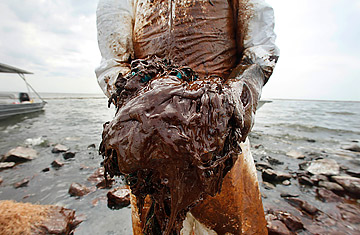
A clean-up worker picks up blobs of oil in absorbent snare on Queen Bess Island at the mouth of Barataria Bay near the Gulf of Mexico in Plaquemines Parish, Louisiana.
The bigger the mess a big corporation finds itself in, the slipperier its use of language becomes. In the 52 days since its oil has been fouling the Gulf of Mexico, BP spokespeople have proven themselves masters of the art of linguistic obtuseness. There's been the company's promise to pay all "legitimate" claims, as well as its pledge to make things "right" in the Gulf — without ever explaining just how it defines legitimacy and rightness and who gets to make the call. Then too, there's BP's use of the word "estimate" — usually meant to imply "just an estimate" — when it speaks of the government's calculations about how much oil is pouring into the Gulf each day.
It's no wonder BP wants to cast doubt on the numbers, since they've been rising steadily rising for weeks. Initially, the company claimed that only 1,000 to 5,000 bbl. were leaking per day. On May 27, the U.S. Geological Survey (USGS) announced that a more accurate figure was 12,000 to 19,000 barrels. That calculation came from infrared scans of the surface of the Gulf, low-resolution videos of the bleeding wellhead, and measurements of the oil that was being collected by a narrow collection tube inserted in the broken riser pipe in mid-May.
On June 10 came the latest — and most staggering — update: According to the government's Flow Rate Technical Group, a multi-department team of experts appointed on May 19, anywhere from 20,000 to 40,000 bbls. are gushing from the busted wellhead every 24 hours. That's a maximum of 1.68 million gallons per day — or one Exxon Valdez disaster every 6.4 days.
While the government itself acknowledges that these rates are, as BP says, estimates, they're ones that have been crunched by scientists whose paychecks aren't signed by the company doing the polluting. What's more, detailed studies using multiple measurement techniques are planned for the days ahead, and they should should settle the matter with about as much certainty as science can muster. "Top government and independent scientists are working nonstop to analyze all the information available and refine assessments," said incident commander Adm. Thad Allen in a statement Thursday.
BP, of course, has a very real financial interest in keeping the leak numbers as low as possible. The post-Exxon Valdez Oil Pollution Act of 1990 authorizes the government to impose civil penalties of $1,000 per barrel when a spill occurs, a figure that jumps to $4,300 if gross negligence can be established. In BP's case, that could add up to a penalty of $10.75 billion and counting — and there may be months of flow still to go. Even for a company that made a profit of $17 billion last year, that's not walk-around money.
The government's efforts to get the true measure of both the environmental and legal damages had been stymied by a lack of good, sharp, high-definition videos that could allow for a crisper analysis of the flow rate. BP officials had those videos but did not hand them over until Washington formally ordered them to do so — and it was studying those images that yielded Thursday's 20,000 to 40,000 bbls. figure. The company has tried to frame its eventual compliance with federal demands as a display of team-spiritedness.
"They provide the estimate, we provide the data," BP spokesman Jon Pack said. "Marcia McNutt [head of the USGS] was quoted as saying they're drowning in high-res video." Maybe, but with the Gulf drowning in oil — and the videos showing how bad the deluge is — it's no wonder BP held out for as long as possible.
The news for the oil giant, to say nothing for the Gulf region, is likely only to get worse. The videos were taken before the riser pipe was sawed off on June 3 to accomodate the containment dome that's helped funnel nearly 15,000 bbl. of oil per day to a holding ship. BP acknowledged in advance that the very act of cutting the pipe could boost the leak rate by 20%. Many experts worry that the increase could be much higher — perhaps multiples of the original flow — since the loss of up to 5,000 ft. of kinked and fractured piping may have relieved pressure that was holding some of the oil back.
Allen thus announced on Thursday that he was ordering NOAA chief McNutt and Energy Secretary Steven Chu to conduct a more detailed, multi-part analysis of the leak rate that should produce a much more reliable figure. The study will include more video modelling of the leak and infrared scans of the surface of the Gulf, as well as pressure readings from the broken blowout preventer. It will also use geological data to study pressure, temperature and other conditions in the reservoir beneath the sea floor from which the oil is coming, and at points along the sea floor from which trace quantities of oil leak naturally. Acoustic analyses conducted by the Woods Hole Oceanographic Institute will also be used.
"Each of the methodologies has advantages and shortcomings," McNutt says, "which is why it is so important that we take several approaches to solving this problem."
Precisely when the new results will be in is not clear. Allen will say only that they'll be available "in the coming days." BP, for its part, seems to have given up fighting what the government scientists are increasingly proving. "They're the guys qualified to [analyze] it," says Pack. "They've got lots of deep scientific expertise. The numbers are the numbers." That they are — and they're ones that will cost both the Gulf and BP dearly.
